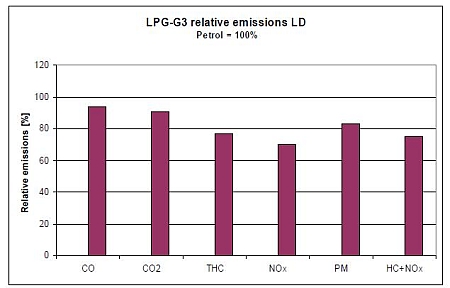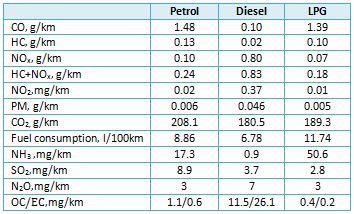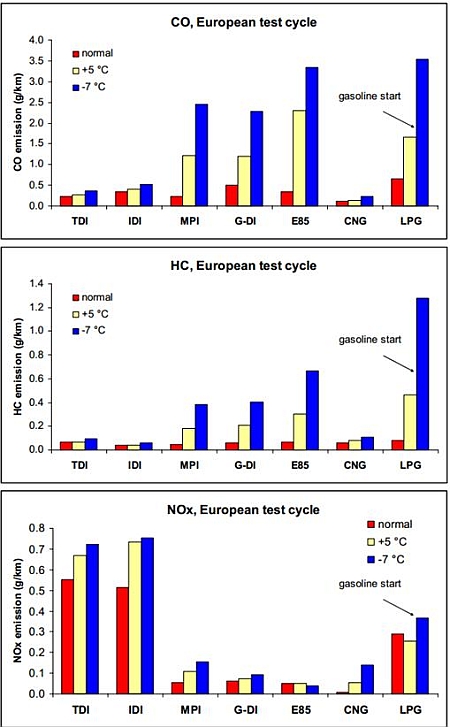Emissions
Regulated emissions are dependent on the vehicle type (OEM or retrofit, bi-fuel or dedicated, injection type, age etc.), but with proper designing, somewhat better emission performance can be achieved in modern vehicles compared to gasoline. Compared to diesel, lower NOx and particulate matter emissions can be obtained, whereas CO and HC emissions are typically higher with LPG (similar to gasoline). Compared to natural gas, emission performance is worse, but distribution and storage are easier.
Certification and emission requirements of LPG vehicles vary (Verbeek 2008). Fuel consumption and CO2 emissions are typically the same or little bit lower with the LPG fuel than with gasoline. Compared to diesel engines, LPG engine is 10–15% less efficient when it is operating at its optimal range. In practice the share of partial load is dominating, therefore "the real world" difference compared to diesel can be higher.
In a study by Tasic et al. (2011) emissions with gasoline and LPG were compared using a modern Opel Zafira with four cylinder 1800 cc Ecotec engine as the test vehicle. It had been converted with a Landi Renzo kit to run also with LPG. The results showed that the emissions were clearly lower with LPG than with gasoline. According to TNO's (Dutch Organization for Applied Scientific Research) measurements, regulated emissions of OEM equipped LPG vehicles are generally equivalent or lower than those of gasoline fuelled vehicles (Figure 2, Table 2, Verbeek et al. 2008). Diesel vehicles emitted lower CO, HC, NH3 and CO2 emissions compared to LPG, whereas other emissions from LPG vehicles were lower than for diesel. Particulate matter emissions of diesel vehicles were high when compared with LPG vehicles. Verbeek et al. (2008) studied also unregulated emissions with LPG vehicles (polyaromatic hydrocarbons, aldehydes and individual hydrocarbons). Overall, the human health effects were very low for LPG with a hot engine. LPG bi-fuel vehicles typically start with gasoline. Therefore during the cold start and warming up emission behavior of LPG vehicles resemble that of gasoline vehicles.(Hendriksen 2003, Verbeek 2008).

Figure 2. The emissions with LPG vehicle compared to gasoline fuelled vehicle. Gasoline = 100%. (Hendricsen 2003).
Table 2. Example of emissions with gasoline, diesel and LPG fuelled vehicles.

Retrofitted LPG vehicles gave higher emissions than OEM equipped LPG vehicles, although the performance of retrofit kits has improved already in 2003. (Hendriksen 2003, Verbeek 2008).
Aakko and Nylund (2003) studied different alternative fuels at normal, +5 and -7 °C temperatures. The LPG car in this study was a prototype. The LPG-powered car produced higher CO, HC and NOx emissions than gasoline powered cars (Figure 3). Compared to the diesel fuelled car, LPG showed lower NOx and particulate matter emissions. Formaldehyde emissions were higher for the LPG car than for the gasoline car, but at the same level as with diesel cars. CO, HC and individual hydrocarbon emissions increased substantially at low temperatures when compared to normal temperature, similar to gasoline cars. In the study by Nylund et al. (1996) The LPG car showed low emissions in all conditions when compared to gasoline and diesel cars at that time.

Figure 3. Regulated emissions with diesel (TDI, IDI), gasoline (MPI, G-DI), E85, CNG, and LPG fuels. (Aakko and Nylund 2003).


